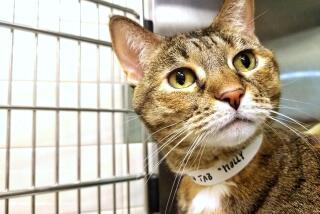Feed a Shedder? Remedies to 2 Pet Peeves
- Share via
A colleague has often remarked on my good grooming and keen dress sense. I admit I’ve occasionally suspected she was making fun (though I would like to point out it wasn’t me wearing a purple Hawaiian shirt and orange lipstick the other day). But maybe not.
Today, for instance, I am wearing black fuzzy pants with white cat hair stuck all over them and a slinky black top with white cat hair stuck all over it. And in my mailbox I’ve just received the perfect, matching accessory: a black fuzzy binder with white cat hair stuck all over it. (Uncanny. How did they know what I’d be wearing today?)
The binder, it turns out, is a gimmick from a company offering an old family recipe purported to stop pets from continually shedding. Such shedding, the company further tells us, is a sure sign of nutritional deficiency. Could it be that my cats’ daily, outraged yowling by the food bowls is justified?
Not too likely, says Dr. Bonnie Beaver, a veterinarian at Texas A&M; University. Shedding, she says, is (a) totally natural and (b) an occupational hazard of pet ownership, though I could avoid having a floor positively drifting with dog and cat hair if I occasionally groomed my pets (blush).
True, she says, stress and illness can ratchet up the rate of shedding (consult your vet if you’re worried) and so, sometimes, can poor nutrition. “But that’s got to be really poor nutrition,” she says. Major-brand pet foods should be fine.
Beaver found another remedy we asked her about more credible--one that seeks to help with another downside of pets: flatulence (giggle) in dogs. This, we’ve learned, is a topic of great interest to the scientists at England’s Waltham Center for Pet Nutrition who enlisted the help of one golden retriever, five Labradors and two English mastiffs to test a solution to the problem. (Read more about it online, at https://www.thescientist.com/researcharchive.htm.)
The research involved, among other things, collecting five days’ worth of gas from dogs’ behinds, using chemical sensors and human noses to assess the samples’ smelliness and writing up a research paper peppered with terms such as “flatulence-free intervals”: If I’d known research could be like this, maybe I’d still be working in labs.
The bottom line: Doggie treats containing activated charcoal, extract of a certain yucca plant and zinc acetate reduced the odor (although not the volume) of gas produced.
“I’m not a flatulence expert,” comments Beaver, “but when you look at the ingredients it’s reasonable to think they have a possibility of helping.” For instance, activated charcoal is good for absorbing all kinds of chemicals including smelly hydrogen sulfide, and yucca contains antibacterial chemicals that could impede the growth of gut bacteria that make the smells.
The Nose Knows Other Things Drifts of cat hair. Airborne waves of malodor. It’s enough to make one have negative thoughts about one’s cat or dog. Therefore we will end this Pet Special with an uplifting item from https://www.healthscout.com, which describes how certain dogs can sniff out cancers on their owners’ legs (and how one even tried to bite the growth off). Others can sense when their diabetic or epileptic owners are low on blood sugar or about to have a fit. Are such Rin-Tin-Tin-to-the-rescue tales true? And could one apply these abilities on a large scale--enlist, say, droves of melanoma-sniffing dogs at medical centers?
Beaver says there is truth to such stories: In fact, there are seizure-sensing dogs busy at work in this country. No one knows how they do it--and lots of dogs just can’t--but there’s a good chance that sensing slight changes in body posture or facial expression could be at the root of it. And who knows, she says--maybe cancerous tumors smell slightly different and dogs with their prodigious noses pick up on that. After all, they’re already sniffing out drugs at airports, people after earthquakes, even--in one case we read about--tracking down fish hidden in bushes by poachers.
Beaver says it may not be very practical to use dogs to sniff out suspicious-looking moles. “Mostly people say, ‘If it looks bad I’m going to take it off and look at it under the microscope anyway, rather than put the person’s ear or shoulder or whatever up to a nose,” she says. Maybe so, but if someone ever trains dogs that can sniff out ripe melons, unscrupulous mechanics, slimy boyfriends . . . they’ll get rich.
If you have an idea for a Booster Shots topic, write or e-mail Rosie Mestel at the Los Angeles Times, 202 W. 1st. St., Los Angeles, CA 90012, rosie.mestel@latimes.com.






